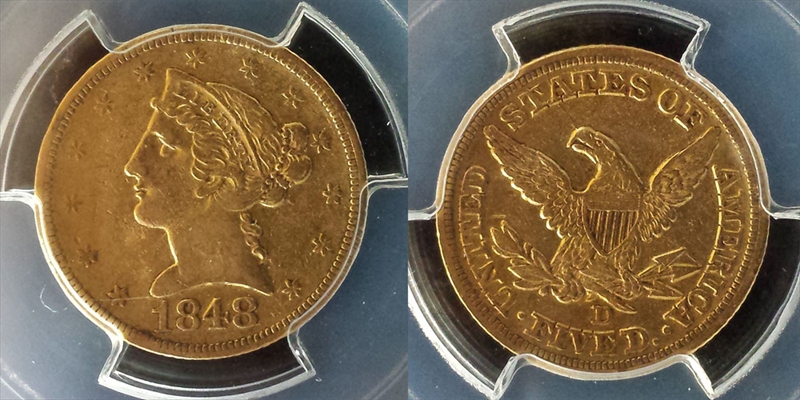1848-D $5 XF45 认证号25254542, PCGS号8238
拥有者评论
Sharp reverse, soft around stars on obverse 9:00 position; crusty
专家评论
Doug Winter
The 1848-D is often regarded as one of the more common Dahlonega half eagles. This is most definitely not the case as it is actually quite scarce in any grade and very rare in high grades.The 1848-D half eagle is a scarce and undervalued issue. Most grade Very Fine to Extremely Fine. Any coin grading About Uncirculated is rare and any About Uncirculated example with good eye appeal is very rare. In Mint State, the 1848-D half eagle is extremely rare.
STRIKE: The quality of strike depends on which die variety a specific coin is. Many examples are very poorly struck and show pronounced flatness at the obverse center and heavy die swelling. Others have clashmarks at the mouth of Liberty and behind the head and weakness on the neck feathers of the eagle. The reverse is generally better struck, even on the coins which show extreme weakness on the obverse. Any example with a sharp overall strike is very rare. For more information on strike, refer to Die Varieties below.
SURFACES: Most 1848-D half eagles have numerous abrasions on the surfaces. This is one of the most difficult Dahlonega half eagles to locate with clean fields. Examples exist with matte-like surfaces from exposure to seawater. These coins have Mint State sharpness but are generally accorded the same value as an Extremely Fine coin with original surfaces.
LUSTER: This date shows below average quality luster. On the few original, higher grade coins that exist, the luster is usually frosty in its texture. On the typical piece the luster is impaired and has a slightly grainy texture.
COLORATION: Due to the fact that so many have been cleaned, it is very difficult to find an 1848-D half eagle with pleasing natural coloration. The few original pieces which exist have darker green-gold or orange-gold hues.
EYE APPEAL: The 1848-D is one of the most difficult Dahlonega half eagles to locate with good eye appeal. Many are very poorly struck and most show serious, detracting abrasions. A piece with good eye appeal is legitimately rare and it deserves to sell for a significant premium over a typical example.
PERSONAL OBSERVATIONS: The 1848-D half eagle is actually one of the hardest Dahlonega issues of any denomination to locate with good eye appeal. Most are either poorly struck or have been cleaned at one time. I cannot recall having seen more than two or three pieces that I felt were genuinely attractive and have seen only one (the Duke’s Creek coin) that I felt was unquestionably Uncirculated.
DIE VARIETIES:
Variety 18-M: The date is large and high and slants downward from left to right. The second 8 in the date is about the same distance between the neck and the denticles. The reverse was used to strike half eagles in 1847 and in 1848. The upright of the mintmark is over the left edge of the upright of the E in FIVE. The left edge of the right serif of the mintmark is over the right diagonal while the right edge is over the E. The mintmark is close to the stem at the upper right and is away from the feather.
At least three die states are known:
STATE I: The stars are sharp and there are no die cracks, clashmarks or traces of swelling.
STATE II: Stars three through six are now thin and fine as the result of die lapping. Clashmarks can be seen at the mouth of Liberty and behind her throat.
STATE III: The stars have become less defined and the clashmarks are more pronounced. Reverse cracks have forme3d from the eagle’s left wing down into the arrows and into the RI in AMERICA. Die State II and Die State III coins are usually seen in low grades and they are extremely rare in AU-55 or better.
Variety 19-O: The obverse is very similar to that described above. On the reverse the mintmark is large a far from the branch. It is connected to the feather tip by a die line. It is noticeably tilted to the right and positioned above the upright of the E. There is a small crack from below the F across IVE to the right pellet.
David Akers (1975/88)
A few pieces graded uncirculated by the cataloguers showed up in my 337 catalogue survey, but none in the past decade. Even AU pieces have been conspicuously absent from most major sales. The conclusion that this date is a rare one in all grades is unmistakable and above EF it must be considered a major rarity. As a date, it is considerably more rare than the 1843-1847 Dahlonega Mint coins, and it is approximately equal in overall rarity to the 1849-D and 1950-D that follow. Expect to find only Fine to EF specimens if looking for this date.PCGS #
8238
设计师
Christian Gobrecht
边缘
Reeded
直径
21.65 毫米
重量
8.36 克
铸币数量
47465
金属成分
90% Gold, 10% Copper
更高评级数量
76
评级较低的钱币数量
77
地区
The United States of America
价格指南
PCGS 数量报告
拍卖 - PCGS 评级的
拍卖 - NGC 评级的
稀有性和存量估计 了解更多
| 所有评级 | 175 |
| 60或以上 | 6 |
| 65或以上 | 0 |
| 所有评级 | R-7.2 |
| 60或以上 | R-9.7 |
| 65或以上 | R-10.1 |
| 所有评级 | 55 / 112 TIE |
| 60或以上 | 29 / 112 TIE |
| 65或以上 | 1 / 112 |
| 所有评级 | 87 / 218 TIE |
| 60或以上 | 54 / 218 TIE |
| 65或以上 | 1 / 218 |























